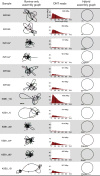Completing bacterial genome assemblies with multiplex MinION sequencing
- PMID: 29177090
- PMCID: PMC5695209
- DOI: 10.1099/mgen.0.000132
Completing bacterial genome assemblies with multiplex MinION sequencing
Abstract
Illumina sequencing platforms have enabled widespread bacterial whole genome sequencing. While Illumina data is appropriate for many analyses, its short read length limits its ability to resolve genomic structure. This has major implications for tracking the spread of mobile genetic elements, including those which carry antimicrobial resistance determinants. Fully resolving a bacterial genome requires long-read sequencing such as those generated by Oxford Nanopore Technologies (ONT) platforms. Here we describe our use of the ONT MinION to sequence 12 isolates of Klebsiella pneumoniae on a single flow cell. We assembled each genome using a combination of ONT reads and previously available Illumina reads, and little to no manual intervention was needed to achieve fully resolved assemblies using the Unicycler hybrid assembler. Assembling only ONT reads with Canu was less effective, resulting in fewer resolved genomes and higher error rates even following error correction with Nanopolish. We demonstrate that multiplexed ONT sequencing is a valuable tool for high-throughput bacterial genome finishing. Specifically, we advocate the use of Illumina sequencing as a first analysis step, followed by ONT reads as needed to resolve genomic structure.
Keywords: Klebsiella pneumoniae; genome assembly; hybrid assembly; long-read sequencing; multiplex sequencing; oxford nanopore.
Figures

References
-
- Holt KE, Wertheim H, Zadoks RN, Baker S, Whitehouse CA, et al. Genomic analysis of diversity, population structure, virulence, and antimicrobial resistance in Klebsiella pneumoniae, an urgent threat to public health. Proc Natl Acad Sci USA. 2015;112:E3574. doi: 10.1073/pnas.1501049112. - DOI - PMC - PubMed
Publication types
MeSH terms
LinkOut - more resources
Full Text Sources
Other Literature Sources

